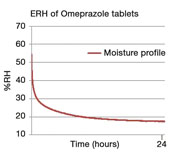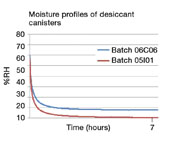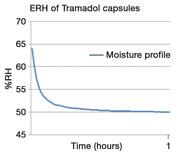Moisture can be detrimental to drug product shelf-life. Peter Moir, Relequa Analytical Systems, describes how moisture profiling via the Equilibrium Relative Humidity can highlight moisture problems in drug materials.
The importance of Equilibrium Relative Humidity (ERH), alternatively known as Water Activity, in the food industry for shelf-life determination is well documented.1 The exposure of pharmaceutical products to moisture and the subsequent effect on the chemical or physical stability of moisture-sensitive products can have serious implications during manufacture and for shelf-life.
The interaction of pharmaceutical products with environmental moisture is governed by the same factors as for any moisture-sensitive material. Water molecules are readily absorbed or lost until an equilibrium – the material’s ERH – is reached; this can be measured by the relative humidity of the surrounding air. This methodology is more widely accepted for microbiological control of pharma products and is the subject of a chapter in the USP <1112> “Application of Water Activity Determination to Nonsterile Pharmaceutical Products”.
For any particular formulation, the rate and extent of water uptake or loss is complex and depends on the chemical and physical properties of the various ingredients and their moisture content
ERH can be defined as the percentage relative humidity (%RH) at which equilibrium is achieved. For any particular formulation, the rate and extent of water uptake or loss is complex and depends on the chemical and physical properties of the various ingredients and their moisture content. Moisture sorption studies have been undertaken by several authors in attempts to understand moisture transfer between materials. The aim is to predict the moisture transfer between pharmaceutical excipients in multicomponent pharmaceutical mixtures, final tablet formulations2 and capsules,3 and moisture uptake by packaged products during shelf life.4
It is important to know when a material or product will absorb or lose moisture. Knowing the ERH, one can predict if a material is likely to absorb or lose moisture at a given %RH. If the environmental humidity is above the ERH a material will absorb moisture, whereas below the ERH drying will take place. It is therefore of great benefit if the ERH of a pharmaceutical formulation or product is known so that the processing and packing environment can be controlled.
The ideal situation is to limit significantly or prevent unwanted moisture uptake, or loss, at any stage of the manufacturing process through to packaging and storage.
ERH is a property of a material that can be used to ‘drive’ a Moisture Profile. Most materials exposed to a %RH above their ERH will always absorb moisture. The moisture profiling approach is entirely empirical, requires no calculations and exploits this property of materials. The moisture profiles generated can be used to gain valuable information and insights into the behaviour of moisture in raw materials and finished products. The following study was carried out using Omeprazole tablets and Tramadol capsules. The results demonstrate the importance of understanding the equilibrium that pharmaceutical products establish with moisture in the air within the local environment.
materials and method
Materials used: Tramadol Capsules 50mg and Omeprazole Tablets 20mg – both are generic brands.
Moisture Profiling Systems: Tablets, capsules and desiccant were analysed using a Relequa system (Relequa Analytical Systems Ltd, Ireland), shown schematically in Figure 1. Tablets or capsules were added directly to the test chambers. Desiccant canisters were fixed into the closure of the test chamber. The downloaded data was presented graphically using Excel templates to generate the moisture profiles.
results and discussion
Moisture Profiling Studies: The approach adopted for the studies described below is very much empirical. No pre-conditioning of samples was performed and they were used ‘as is’. Experience of the author has shown that the moisture profile can be influenced by exposure of the sample to high or low humidity, depending on how ‘active’ the material is regarding moisture sorption. The studies described below examine tablets and capsules as received in their normal packaging/containers and the results reflect their ‘real life’ situation.

Figure 2: Measurement of the Equilibrium Relative Humidity of Omeprazole tablets
Hygroscopic Tablets: Omeprazole tablets obtained from a local pharmacist were tested as an example of a known hygroscopic material. Ten tablets were set up to measure their %ERH at ambient temperature (Figure 2). Clearly the tablets are ‘active’ and after about 24 hours gave an ERH of around 17%. Furthermore, the initial drop in %RH is very rapid, which means that any exposure to ambient humidity could result in immediate moisture uptake. These tablets are supplied in HDPE containers with a desiccant canister in the cap.
It can be seen from Figure 2 that the presence of desiccant is important, if not essential, for protection against moisture and stability of the product. Exposure to relative humidity above 17% will certainly result in moisture uptake.
Protecting products with internal desiccant was investigated further as described below:
Desiccant canister – 28-day in-use check: A pack of Omeprazole tablets contains 28 tablets, one to be taken daily. They are packed both in plastic bottles and blisters. When supplied in HDPE bottles, the container obviously must be opened for removal of a tablet and the cap replaced. This was performed on a daily basis under ambient conditions. The author resides in Ireland where the relative humidity is normally in the range 50–75%RH, with an annual average of 60–65%RH. Moisture ingress could be significant under these conditions.

Figure 3: Measurement of the moisture profiles of desiccant canisters after in-use testing of opening and closing once daily over 28 days
To test the protective capability of the internal desiccant, the canisters were removed from the lids of two bottles of different batch numbers of Omeprazole tablets following daily opening and closure for 28 days. The moisture profile of the desiccant was measured as shown on the schematic in Material and Methods and the results are presented in Figure 3.
After repeated exposure to moisture the desiccant is still able to establish a low ERH within the HDPE container. Moreover, the rate of moisture sorption is much faster than the tablets. Note that the ERH of Batch Nos. 06C06 and 05I01 are about 17% and 10% respectively. The difference in ERH is greater than the accuracy of the humidity probe (± 3%RH) and probably reflects some moisture uptake resulting in loss of capacity of the desiccant from Batch No. 06C06. Nevertheless, the ERH for both lots of desiccants is close to, or lower than the ERH of the Omeprazole tablets shown in Fig. 2, and would still provide protection from moisture.
It is reassuring for the patient that this type of packaging is still effective after its normal in-use period.
Hard Gelatin Capsules: Published literature by a number of workers5–7 has highlighted potential stability issues with hard gelatine capsules. In common with other polymers, gelatin contains water bound in different ways8 and is an essential part of the gelatin and the capsule properties.
It is thought that movement of water can occur between the gelatin and the encapsulated product. After a time an equilibrium is reached by sorption/desorption. This equilibrium depends on the initial water content of the gelatin and the capsule contents. Figure 4 shows the ERH of 10 Tramadol capsules.

Figure 4: Measurement of the moisture profile of Tramadol capsules
The initial drop in humidity shows that the capsules are ‘active’ and hence the container in which the product was stored in the pharmacy has provided an adequate barrier to moisture. The ERH of 50% will result in moisture uptake in an environment where the humidity averages about 10% above the %ERH. Moisture ingress may have occurred, but the packaging has been sufficiently protective over the actual shelf-life. Assuming that long-term ICH stability studies (25ºC/60%RH or 30ºC/65%RH) are performed on this product over its claimed shelf-life, the above result supports the package type for this particular product.
Considering the data from Figures 3 and 4, the use of a desiccant with hard gelatin capsules is inadvisable as the desiccant would absorb moisture continuously from the capsules, causing them to dry out, crack and split.
Repeatability of ERH Measurements: The ERH of samples of Omeprazole tablets and Tramadol capsules was measured several times to assess repeatability of the test system.
The results in Table 1 show an acceptable precision of the ERH measurements. During these tests some observations were made that should be taken into consideration when performing these determinations.
When testing Omeprazole tablets it is best to test separate samples taken from the marketed container and not retest the same sample of tablets. The reason is that sample handling under ambient humidity leads to absorption of moisture by the tablets resulting in an increased ERH measurement. This is a sample conditioning effect that changes the moisture status of a material and has been described by others due to the presence of desiccant in the packaging.9 Because there are 28 tablets in the pack of Omeprazole tablets, the results in Table 1 were generated from two different packs of tablets and this may have contributed to a greater standard deviation than the true value.
In the case of the Tramadol capsules the same 10 capsules were used for the five measurements reported in Table 1. This sample of capsules came from the same lot that was used to generate the data in Figure 4 and show an increase in the ERH. These capsules had not been kept in an air-tight container. Over a period of several weeks between initial testing and the repeatability runs, the capsules had taken up moisture from an environment where the ambient humidity was 60–70% and often higher. By the time of the later tests, the capsules had established a new ERH of about 70%.
| Table 1: Repeatable ERH measurements | ||||
| Omeprazole Tablets | Tramadol Capsules | |||
In conclusion, the Relequa system provides a convenient tool for studying moisture profiles of materials. Various applications are possible, giving new insights and an understanding of moisture interactions in materials. In addition, moisture sensitivity of materials within the actual conditions of the manufacturing, sample handling and storage environments can be evaluated.
references
1. Dept. of Health, Education, and Welfare Public Health Service Food and Drug Administration. ITG Subject: Water Activity (a w) in Foods. May 16 1984, No.39.
2. Li Y et al. AAPS PharmSciTech. 2003; 4(4): article 59.
3. Chang RK, et al. J Pharm Sci. 1998; 87: 556-558.
4. Chen Y, Li Y. Int J Pharm. 2003; 255: 217-225.
5. Adesunloye TA, Stach PE. Drug Dev Ind Pharm. 1998 Jun; 24(6): 493-500.
6. Chiwele I, et al., Chem Pharm Bull (Tokyo). 2000 Jul; 48(7): 951-6.
7. Kuentz M, Rothlisberger D. Int J Pharm. 2002 Apr 2; 236(1-2):145-52.
8. Agrawal AM, et al. AAPS PharmSciTech. 2003; 4(4): article 60.
9. Badawy SI, et al. Int J Pharm. 2001 Jul 31; 223(1-2):1-13.
This article is an abridged and edited version of the original paper published in Tablets and Capsules, May 2007.




